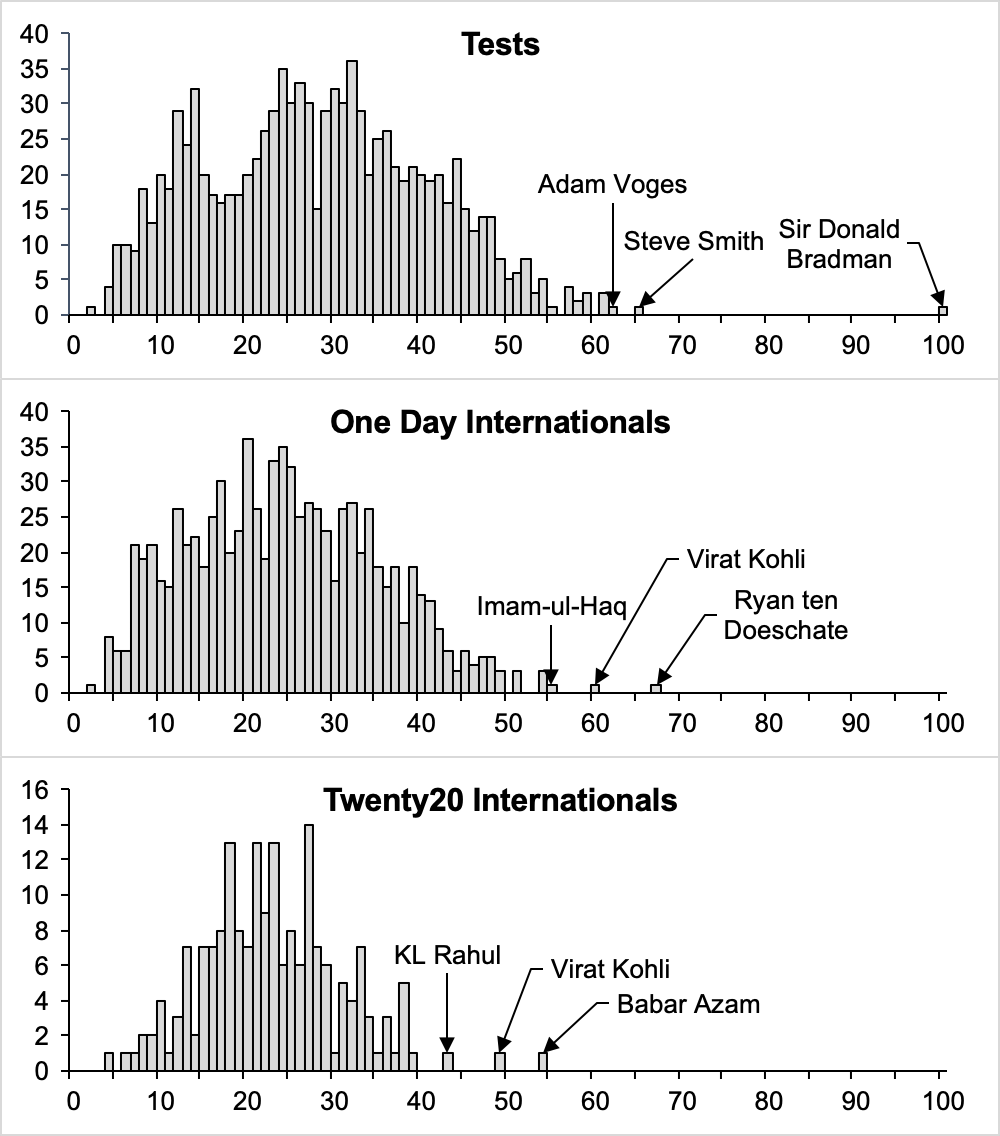|
Denys Witherington
Denys March Witherington (25 July 1921 – 16 February 1944) was an English first-class cricketer and British Army soldier. Witherington was born at Hendon in Sunderland in July 1921, one of three sons of Arthur Simpson and Catherine Witherington. He was educated in Cambridge at The Leys School, where he was a talented schoolboy cricketer who played in the Public School's match at Lord's. After completing his education, Witherington remained in Cambridge where he attended Emmanuel College at the University of Cambridge. While studying at Cambridge, he played first-class cricket for Cambridge University in 1939, making four appearances. Playing as a wicket-keeper, he scored 147 runs in his four matches at an average of 29.40 and a high score of 52 not out. Behind the stumps he also took five catches and made a single stumping. After missing out on a blue in 1939, his studies were interrupted by the onset of the Second World War. During the war he served as a private with the ... [...More Info...] [...Related Items...] OR: [Wikipedia] [Google] [Baidu] |
Hendon, Sunderland
Hendon is an eastern area of Sunderland in Tyne and Wear, North East England, the location of much heavy industry and Victorian terraces and three high-rise residential tower blocks. The area is commonly referred to as the East End of Sunderland. Hendon is west of Sunderland Docks. Shipbuilding in Sunderland began in Hendon with the opening of a shipyard by Thomas Menvill in 1346. The old east end of Sunderland was home to Sunderland Barracks until the 1930s. They were located on the south side near the south docks, near present-day Warren Court (formerly known as Warren Street). The first aluminium bascule bridge in the world, which opened in 1948, spanned the junction of Hendon and Hudson Docks. It suffered from bimetallic corrosion and was demolished in 1977. The Victoria Hall Disaster The Victoria Hall disaster occurred on 16 June 1883 at the Victoria Hall in Sunderland, England, when a stampede for free toys caused 183 children (aged between 3 and 14 years old) t ... [...More Info...] [...Related Items...] OR: [Wikipedia] [Google] [Baidu] |
Emmanuel College, Cambridge
Emmanuel College is a constituent college of the University of Cambridge. The college was founded in 1584 by Sir Walter Mildmay, Chancellor of the Exchequer to Elizabeth I. The site on which the college sits was once a priory for Dominican monks, and the College Hall is built on the foundations of the monastery's nave. Emmanuel is one of the 16 "old colleges", which were founded before the 17th century. Emmanuel today is one of the larger Cambridge colleges; it has around 500 undergraduates, reading almost every subject taught within the University, and over 150 postgraduates. Among Emmanuel's notable alumni are Thomas Young, John Harvard, Graham Chapman and Sebastian Faulks. Three members of Emmanuel College have received Nobel Prizes: Ronald Norrish, George Porter (both Chemistry, 1967) and Frederick Hopkins (Medicine, 1929). In every year from 1998 until 2016, Emmanuel was among the top five colleges in the Tompkins Table, which ranks colleges according to end-of-year ex ... [...More Info...] [...Related Items...] OR: [Wikipedia] [Google] [Baidu] |
1921 Births
Nineteen or 19 may refer to: * 19 (number), the natural number following 18 and preceding 20 * one of the years 19 BC, AD 19, 1919, 2019 Films * 19 (film), ''19'' (film), a 2001 Japanese film * Nineteen (film), ''Nineteen'' (film), a 1987 science fiction film Music * 19 (band), a Japanese pop music duo Albums * 19 (Adele album), ''19'' (Adele album), 2008 * ''19'', a 2003 album by Alsou * ''19'', a 2006 album by Evan Yo * ''19'', a 2018 album by MHD (rapper), MHD * ''19'', one half of the double album ''63/19'' by Kool A.D. * ''Number Nineteen'', a 1971 album by American jazz pianist Mal Waldron * XIX (EP), ''XIX'' (EP), a 2019 EP by 1the9 Songs * 19 (song), "19" (song), a 1985 song by British musician Paul Hardcastle. * "Nineteen", a song by Bad4Good from the 1992 album ''Refugee (Bad4Good album), Refugee'' * "Nineteen", a song by Karma to Burn from the 2001 album ''Almost Heathen''. * Nineteen (song), "Nineteen" (song), a 2007 song by American singer Billy Ray Cyrus ... [...More Info...] [...Related Items...] OR: [Wikipedia] [Google] [Baidu] |
Nazi Germany
Nazi Germany (lit. "National Socialist State"), ' (lit. "Nazi State") for short; also ' (lit. "National Socialist Germany") (officially known as the German Reich from 1933 until 1943, and the Greater German Reich from 1943 to 1945) was the German state between 1933 and 1945, when Adolf Hitler and the Nazi Party controlled the country, transforming it into a dictatorship. Under Hitler's rule, Germany quickly became a totalitarian state where nearly all aspects of life were controlled by the government. The Third Reich, meaning "Third Realm" or "Third Empire", alluded to the Nazi claim that Nazi Germany was the successor to the earlier Holy Roman Empire (800–1806) and German Empire (1871–1918). The Third Reich, which Hitler and the Nazis referred to as the Thousand-Year Reich, ended in May 1945 after just 12 years when the Allies defeated Germany, ending World War II in Europe. On 30 January 1933, Hitler was appointed chancellor of Germany, the head of gove ... [...More Info...] [...Related Items...] OR: [Wikipedia] [Google] [Baidu] |
Battle Of Anzio
The Battle of Anzio was a battle of the Italian Campaign of World War II that took place from January 22, 1944 (beginning with the Allied amphibious landing known as Operation Shingle) to June 5, 1944 (ending with the capture of Rome). The operation was opposed by German forces in the area of Anzio and Nettuno. The operation was initially commanded by Major General John P. Lucas, of the U.S. Army, commanding U.S. VI Corps with the intent to outflank German forces at the Winter Line and enable an attack on Rome. The success of an amphibious landing at that location, in a basin consisting substantially of reclaimed marshland A marsh is a wetland that is dominated by herbaceous rather than woody plant species.Keddy, P.A. 2010. Wetland Ecology: Principles and Conservation (2nd edition). Cambridge University Press, Cambridge, UK. 497 p Marshes can often be found at ... and surrounded by mountains, depended on the element of surprise and the swiftness with which the invade ... [...More Info...] [...Related Items...] OR: [Wikipedia] [Google] [Baidu] |
Loyal Regiment (North Lancashire)
The Loyal Regiment (North Lancashire) (until 1921 known as the Loyal North Lancashire Regiment) was a line infantry regiment of the British Army that was in existence from 1881 to 1970. In 1970, the regiment was amalgamated with the Lancashire Regiment to form the Queen's Lancashire Regiment which was, in 2006, amalgamated with the King's Own Royal Border Regiment and the King's Regiment (Liverpool and Manchester) to form the Duke of Lancaster Regiment (King's, Lancashire and Border). History Formation The Loyal North Lancashire Regiment was formed as part of the Childers Reforms of 1881 by the amalgamation of the 47th (Lancashire) Regiment of Foot, 81st Regiment of Foot (Loyal Lincoln Volunteers), 3rd Royal Lancashire Militia (The Duke of Lancaster's Own) and the 11th and 14th Lancashire Rifle Volunteer Corps. The Loyals were one of seven county regiments recruiting in Lancashire. The depot was at Preston, and the regimental district also included the towns of Bolton, Chorl ... [...More Info...] [...Related Items...] OR: [Wikipedia] [Google] [Baidu] |
Second World War
World War II or the Second World War, often abbreviated as WWII or WW2, was a world war that lasted from 1939 to 1945. It involved the vast majority of the world's countries—including all of the great powers—forming two opposing military alliances: the Allies and the Axis powers. World War II was a total war that directly involved more than 100 million personnel from more than 30 countries. The major participants in the war threw their entire economic, industrial, and scientific capabilities behind the war effort, blurring the distinction between civilian and military resources. Aircraft played a major role in the conflict, enabling the strategic bombing of population centres and deploying the only two nuclear weapons ever used in war. World War II was by far the deadliest conflict in human history; it resulted in 70 to 85 million fatalities, mostly among civilians. Tens of millions died due to genocides (including the Holocaust), starvation, ma ... [...More Info...] [...Related Items...] OR: [Wikipedia] [Google] [Baidu] |
Blue (university Sport)
A blue is an award of sporting colours earned by athletes at some universities and schools for competition at the highest level. The awarding of blues began at Oxford and Cambridge universities in England. They are now awarded at a number of other British universities and at some universities in Australia, Canada and New Zealand. History The first sporting contest between the universities of Oxford and Cambridge was held on 4 June 1827, when a two-day cricket match at Lord's, organized by Charles Wordsworth, nephew of the poet William, resulted in a draw. There is no record of any university "colours" being worn during the game. At the first Boat Race in 1829, the Oxford crew was dominated by students of Christ Church, whose college colours were dark blue. They wore white shirts with dark blue stripes, while Cambridge wore white with a pink or scarlet sash. At the second race, in 1836, a light blue ribbon was attached to the front of the Cambridge boat, as it was the colour of G ... [...More Info...] [...Related Items...] OR: [Wikipedia] [Google] [Baidu] |
Stumps
In cricket, the stumps are the three vertical posts that support the bails and form the wicket. '' Stumping'' or ''being stumped'' is a method of dismissing a batsman. The umpire ''calling stumps'' means the play is over for the day. Part of the wicket The stumps are three vertical posts which support two bails. The stumps and bails are usually made of wood, most commonly ash, and together form a wicket at each end of the pitch. The overall width of each wicket is 9 inches (22.9 cm). Each stump is 28 inches (71.1 cm) tall with maximum and minimum diameters of 1 inches (3.81 cm) and 1 inches (3.49 cm). They have a spike at one end for inserting into the ground, and the other end has a U-shaped 'through groove' to provide a resting place for the bails. In junior cricket the items have lesser dimensions. Each stump is referred to by a specific name: * Off stump is the stump on the off side of the wicket (the same side as the batsman's bat). * Mid ... [...More Info...] [...Related Items...] OR: [Wikipedia] [Google] [Baidu] |
Batting Average (cricket)
In cricket, a player's batting average is the total number of runs they have scored divided by the number of times they have been out, usually given to two decimal places. Since the number of runs a player scores and how often they get out are primarily measures of their own playing ability, and largely independent of their teammates, batting average is a good metric for an individual player's skill as a batter (although the practice of drawing comparisons between players on this basis is not without criticism). The number is also simple to interpret intuitively. If all the batter's innings were completed (i.e. they were out every innings), this is the average number of runs they score per innings. If they did not complete all their innings (i.e. some innings they finished not out), this number is an estimate of the unknown average number of runs they score per innings. Each player normally has several batting averages, with a different figure calculated for each type of match ... [...More Info...] [...Related Items...] OR: [Wikipedia] [Google] [Baidu] |

_at_Anzio.jpg)



